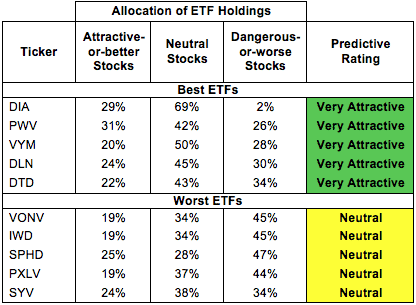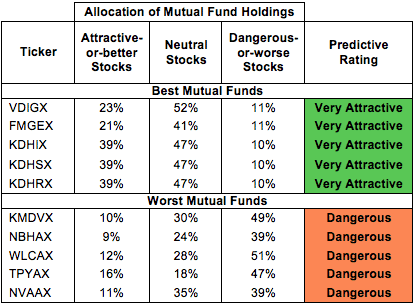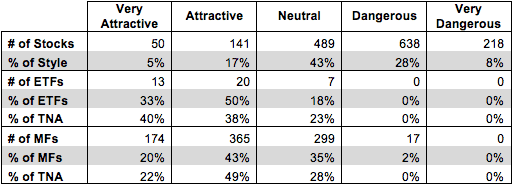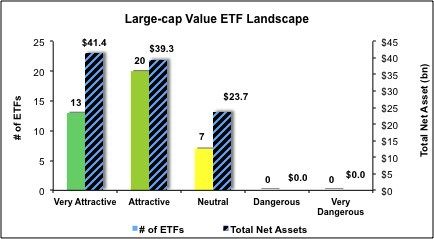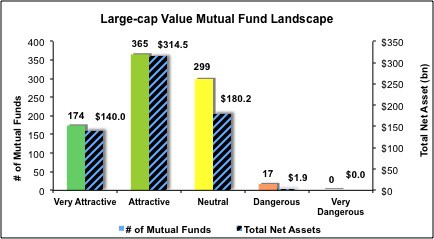The Large Cap Value style ranks second out of the twelve fund styles as detailed in my Style Rankings for ETFs and Mutual Funds report. It gets my Neutral rating, which is based on aggregation of ratings of 40 ETFs and 855 mutual funds in the Large Cap Value style as of July 28, 2014. Prior reports on the best & worst ETFs and mutual funds in every sector and style are here.
Figures 1 and 2 show the five best and worst-rated ETFs and mutual funds in the style. Not all Large Cap Value style ETFs and mutual funds are created the same. The number of holdings varies widely (from 19 to 1010). This variation creates drastically different investment implications and, therefore, ratings. The best ETFs and mutual funds allocate more value to Attractive-or-better-rated stocks than the worst, which allocate too much value to Neutral-or-worse-rated stocks.
To identify the best and avoid the worst ETFs and mutual funds within the Large Cap Value sector, investors need a predictive rating based on (1) the stocks ratings of the holdings, (2) the all-in expenses of each ETF and mutual fund, and (3) the fund’s rank compared to all other ETFs and mutual funds. As a result, only the cheapest funds with the best holdings receive Attractive or better ratings. Investors need not rely on backward-looking ratings. My fund rating methodology is detailed here.
Investors seeking exposure to the Large Cap Value style should buy one of the Attractive-or-better rated ETFs or mutual funds from Figures 1 and 2.
Get my ratings on all ETFs and mutual funds in this style by searching for Large Cap Value on my mutual fund and ETF screener.
Figure 1: ETFs with the Best & Worst Ratings – Top 5
* Best ETFs exclude ETFs with TNAs less than $100 million for inadequate liquidity.
Sources: New Constructs, LLC and company filings
First Trust Capital Strength ETF (FTCS), First Trust NASDAQ Rising Dividend Achievers ETF (RDVY), and iShares NYSE 100 Index Fund ETF (NY) are excluded from Figure 1 because their total net assets (TNA) are below $100 million and do not meet our liquidity minimums.
Figure 2: Mutual Funds with the Best & Worst Ratings – Top 5
* Best mutual funds exclude funds with TNAs less than $100 million for inadequate liquidity.
Sources: New Constructs, LLC and company filings
Managed Portfolio Series: Coho Relative Value Equity Fund (COHIX), Managed Portfolio Series: Coho Relative Value Equity Fund (COHOX), and Mutual Fund Series Trust: Catalyst/Lyons Hedged Premium Return Fund (CLPFX) are excluded from Figure 2 because their total net assets (TNA) are below $100 million and do not meet our liquidity minimums.
State Street SPDR Dow Jones Industrial Average ETF (DIA) is my top-rated Large Cap Value ETF and Vanguard Dividend Growth Fund (VDIGX) is my top-rated Large Cap Value mutual fund. Both earn my Very Attractive rating.
State Street SPDR MFS Systematic Value Equity ETF (SYV) is my worst-rated Large Cap Value ETF and Neuberger Berman Value Fund (NVAAX) is my worst-rated Large Cap Value mutual fund. DIA earns my Very Attractive rating while SYV earns my Dangerous rating.
Figure 3 shows that 191 out of 1536 stocks (over 22% of the market value) in Large Cap Value ETFs and mutual funds get an Attractive-or-better rating. However, 33 out of 40 Large Cap Value ETFs (77% of total net assets) and 539 out 1010 Large Cap Value mutual funds (71% of total net assets) get an Attractive-or-better rating.
Figure 3: Large Cap Value Style Landscape For ETFs, Mutual Funds & Stocks
Sources: New Constructs, LLC and company filings
As detailed in “Cheap Funds Dupe Investors”, the fund industry offers many cheap funds but very few funds with high-quality stocks, or with what I call good portfolio management.
Investors need to tread carefully when considering Large Cap Value ETFs and mutual funds, as 33 ETFs and 539 mutual funds in the Large Cap Value style allocate enough value to Attractive-or-better-rated stocks to earn an Attractive rating.
AFLAC Inc. (AFL) is one of my favorite stocks held by Large Cap Value ETFs and mutual funds and earns my Attractive rating. Since 2009, AFL has grown after-tax profits (NOPAT) by 21% compounded annually. The company currently earns a return on invested capital (ROIC) of 16%, placing it in the top quintile of all companies I cover. AFL has also generated positive economic earnings every year of my model, dating back to 1998. Despite its impressive profit growth, AFL remains valued as a company with very limited growth prospects going forward. At its current price of ~$59/share, AFL has a price to economic book value (PEBV) ratio of 1. This ratio implies that the market expects AFL to never grow NOPAT again for the remaining life of the corporation. Given AFL’s track record of profit growth, this expectation seems rather pessimistic. Currency concerns have weighed on the stock since I recommended it in April, but there is still plenty of upside.
American Water Works Company, Inc. (AWK) is one of my least favorite stocks held by Large Cap Value ETFs and mutual funds and earns my Dangerous rating. American Water Works has grown NOPAT by less than 1% compounded annually over the past five years. AWK generates a ROIC of only 4%, placing it in the bottom quintile of companies that I cover. AWK has also failed to generate positive economic earnings in any year since going public in 2008. Despite AWK’s weak profitability, the stock is still overvalued. To justify its current price of ~$49/share, AWK must grow NOPAT by 8% compounded annually over the next 16 years. Having grown after-tax profits by less than 1% compounded annually over the last five years, this expectation seems unlikely. Investors should avoid AWK.
Figures 4 and 5 show the rating landscape of all Large Cap Value ETFs and mutual funds.
My Style Rankings for ETFs and Mutual Funds report ranks all styles and highlights those that offer the best investments.
Figure 4: Separating the Best ETFs From the Worst Funds
Sources: New Constructs, LLC and company filings
Figure 5: Separating the Best Mutual Funds From the Worst Funds
Sources: New Constructs, LLC and company filings
Review my full list of ratings and rankings along with reports on all 40 ETFs and 855 mutual funds in the Large Cap Value style.
Kyle Guske II contributed to this report.
Disclosure: David Trainer and Kyle Guske II receive no compensation to write about any specific stock, sector, style or theme.

